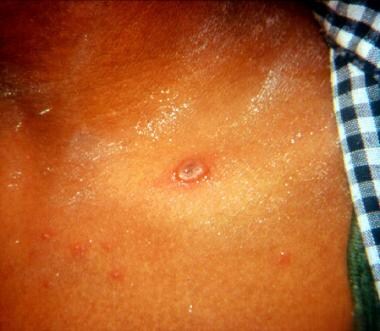History
Chickenpox is usually diagnosed clinically on the basis of the characteristic rash and successive crops of lesions. Lesions may be found in all stages of development and healing in affected sites. A history of exposure to an infected contact within the incubation period of 10-21 days is also an important clue in the diagnosis.
Childhood chickenpox is usually not heralded by a prodrome; it begins with the onset of an exanthem. In adults and adolescents, chickenpox may be preceded by a prodrome of nausea, myalgia, anorexia, and headache. The triad of rash, malaise, and a low-grade fever can signal disease onset, though the typical patient is infectious for 1-2 days prior to the development of rash.
Small, erythematous macules appear on the scalp, face, trunk, and proximal limbs, with rapid sequential progression over 12-14 hours to papules, clear vesicles, and pustules and subsequent central umbilication and crust formation.
Vesicles may appear on the palms and the soles and on the mucous membranes, together with painful, shallow, oropharyngeal or urogenital ulcers. Intense pruritus commonly accompanies the vesicular stage of the rash.
The typical patient remains infectious for 4-5 days after the rash develops, by which time the last crop of vesicles has usually crusted over.
Secondary bacterial infection
Secondary bacterial infection of skin lesions, manifesting as impetigo, cellulitis, and erysipelas, is the most frequent complication in otherwise healthy children. [10] Staphylococci and streptococci are the most commonly implicated bacterial pathogens. Bacterial superinfection may predispose to scarring. Localized bacterial superinfection rarely may manifest as septicemia, culminating in secondary bacterial pneumonia, otitis media, or necrotizing fasciitis. The latter represents significant, potentially life-threatening morbidity.
Disseminated primary varicella infection
Disseminated primary varicella infection, usually seen in the immunocompromised or adult populations, may have high morbidity. Ninety percent of cases of varicella pneumonia occur in the adult population. Rarer complications of disseminated chickenpox include myocarditis, gangrene, hepatitis, and glomerulonephritis. [11] Eczema varicellicum (mimicking eczema herpeticum) can occur. [12]
CNS complications
Central nervous system complications of primary VZV infection may occur, albeit very rarely. Reye syndrome, Guillain-Barré syndrome, acute cerebellar ataxia, and encephalitis have all been documented to occur after VZV infection.
Hemorrhagic complications
Thrombocytopenia and purpura secondary to VZV infection have been described in more than 100 patients. Hemorrhagic complications are more common in the immunocompromised or immunosuppressed populations, although healthy children and adults have been affected. [13]
Five major clinical syndromes have been described:
-
Febrile purpura
-
Malignant chickenpox with purpura
-
Postinfectious purpura
-
Purpura fulminans
-
Anaphylactoid purpura
These syndromes have variable courses, with febrile purpura being the most benign and having an uncomplicated outcome. In contrast, malignant chickenpox with purpura is a grave clinical condition that has a mortality exceeding 70%.
The etiology of these hemorrhagic chickenpox syndromes is not known, although an autoimmune pathophysiologic mechanism has been implicated.
In utero VZV infection
In utero infection with VZV is a concern. [14, 15] Primary maternal chickenpox during pregnancy may produce latency of VZV in the dorsal root ganglia of the fetus. These children may remain asymptomatic, or they may develop zoster at a young age without a previous history of primary chickenpox infection. Primary maternal chickenpox infection in early to mid-pregnancy is estimated to have a 1-2% risk of causing the congenital varicella syndrome, which is characterized by limb hypoplasia, muscular atrophy, skin scarring, cortical atrophy, microcephaly, cataract formation, and rudimentary digits.
Prepartum infection with onset of chickenpox in the mother 5 or more days previous to delivery allows transplacental passage of sufficient maternal IgG antibody to protect the newborn from severe, disseminated varicella infection.
Peripartum infection of the fetus before sufficient maternal antibody has crossed the placenta to confer transient passive immunity to the fetus (ie, when the mother experiences onset of chickenpox < 5 d before delivery or within 2 d after delivery) often results in severe disseminated varicella in the newborn infant, which has substantial mortality.
Physical Examination
The characteristic chickenpox vesicle, surrounded by an erythematous halo, is described as a dewdrop on a rose petal [16] (see the images below).
 Dewdrop on rose petal characteristic vesicle of chickenpox. Reprinted with permission from Cutis 65: 355, 2000.
Dewdrop on rose petal characteristic vesicle of chickenpox. Reprinted with permission from Cutis 65: 355, 2000.
 Vesicular eruption on the trunk demonstrating papules, vesicles, and crusts. Reprinted with permission from Cutis 65: 355, 2000.
Vesicular eruption on the trunk demonstrating papules, vesicles, and crusts. Reprinted with permission from Cutis 65: 355, 2000.
Chickenpox is clinically characterized by the presence of active and healing lesions in all stages of development within affected locations. Lesions characteristically heal without scarring, although excoriation or secondary bacterial superinfection predisposes to scar formation.
Adults with chickenpox have a more complicated course than that occurring in children. Adults may experience a more widespread rash; prolonged fever; and an increased likelihood of complications, the most common being varicella pneumonia.
Clinical variants of chickenpox infection also occur. Hemorrhagic lesions are rare and are most commonly associated with patients who are immunocompromised or immunosuppressed.
Bullous chickenpox is a rare variant in which bullae appear instead of the characteristic vesicles. [17, 18] The possibility of bullous impetigo from Staphylococcus aureus must be addressed, especially in a child with persistent fever or relapse after he or she appeared to be improving.
Bullous chickenpox may affect both children and adults and must be differentiated from other bullous disorders (eg, bullous pemphigoid, pemphigus). The course of the disease is believed to be unchanged, although a delay in diagnosis and treatment of elderly patients and immunocompromised patients may lead to serious morbidity.
Chickenpox and other viral exanthems may appear concentrated in areas where intense sun exposure occurred during the incubation period. Patients with atopic dermatitis may show an atypical distribution of varicella, in which the characteristic eruption is primarily found on lichenified areas. [16, 19] An atypical presentation may also occur in areas of cutaneous irritation, such as sun exposure or pre-existing inflammation. [20]
-
Dewdrop on rose petal characteristic vesicle of chickenpox. Reprinted with permission from Cutis 65: 355, 2000.
-
Vesicular eruption on the trunk demonstrating papules, vesicles, and crusts. Reprinted with permission from Cutis 65: 355, 2000.









